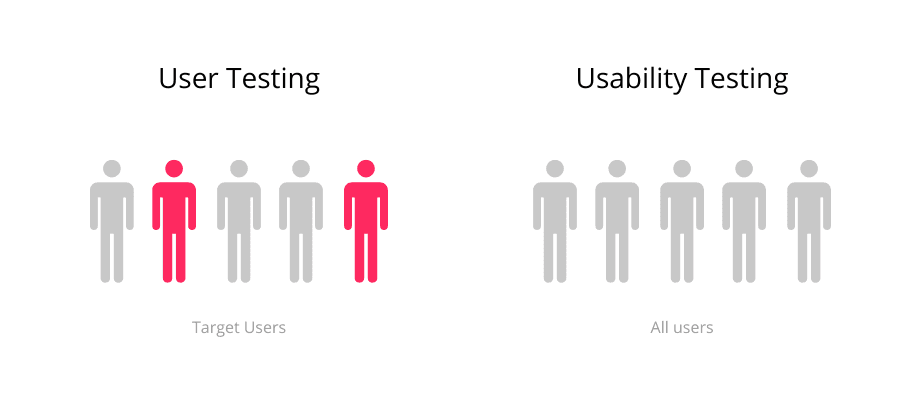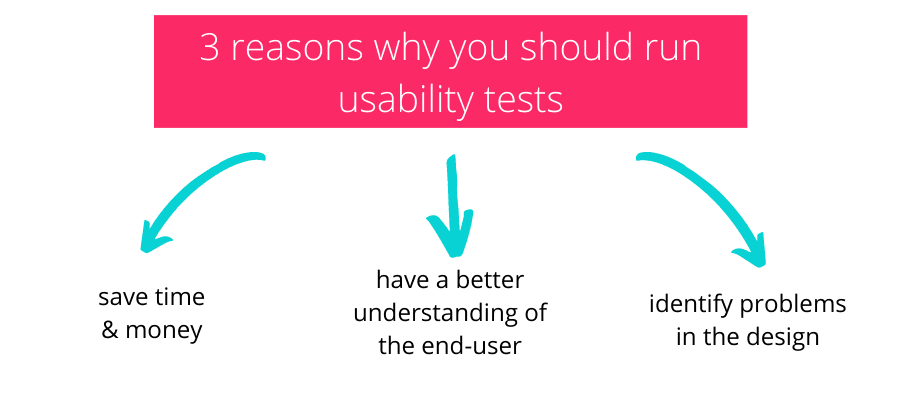November 5, 2025
9 min read
User testing vs. usability testing: Key differences & when to use each (UX Guide)
Are you looking for ways to evaluate your product and get rid of usability problems? You came to the right place. User testing and usability testing are the two methods that involve actual users.

Most teams confuse user testing with usability testing, but they solve different problems and happen at different moments in product development. User testing checks whether users want what you’re building. Usability testing checks whether they can use it successfully.
Their purpose is to provide a great User Experience (UX) and an intuitive user flow, based on user feedback and test results.
There are different types of usability methods.
What you should know is that User Testing and Usability Testing are not the same thing.
It is common to confuse one method with the other, but there are significant differences between them including the development process, phase of use and focus group.
Given the extreme importance of this topic, we decided to dedicate a whole article to it, as it's a foundational concept for customer journey optimization.
Before we dive into details let’s start with a fundamental dictionary definition of user testing and usability testing.
User testing: Are we building the right product?
User testing is one of the methods that allow you to understand user needs and confirm (or smash) your ideas.
User testing usually appears at the early stage, sometimes even at a rough draft of your product. Why? Because it informs you whether your users really are interested in your product or is it only you.
From the user testing sessions, you can also learn who is your buyer persona and target audience. Thanks to that, you'll be able to provide better content for web pages that include Customer Value Propositions (CLV).
In simpler words, user testing enables you to gather feedback that determines whether it makes sense to even release such a product, feature, or app.
Usability testing: Are we building the product right?
Then you have usability testing. It is a method that estimates a product's usefulness and efficacy for future users or an actual one.
This method can be carried out through a prototype or a design process phase (and even later).
A lot of companies start to run usability testing methods at a very early stage. It's easier and cheaper to find usability issues and enter changes that were highlighted in a usability testing report at this stage.
To understand it better, imagine that you've just launched a new e-commerce website with a user interface that not only can be scrolled horizontally but also vertically. According to the agency, it's one of the latest trends in web design that actually engages real users.
After 1 month of releasing the new website, you decided to check the results from it by checking Heatmaps. You saw with horror that no one interacted with it. This is where behavioral analytics tools and user behavior analysis shine.
If the agency provided usability tests, they would spot that such an element is not useful or intuitive for real users.
Based on results gathered from test sessions with representative users, an agency could easily identify areas that require improvements, which is essential if you want to learn how to increase conversion rate.
User testing vs. usability testing: Key differences
There are very clear differences between these two testing methods.
The aim

By using a user testing method, you can determine whether users are interested in the solution you're considering. This method validates an idea and determines the success of your product.
Usability testing gives you all the answers that are necessary to provide a great user experience and usability. This method mostly validates UX design. Of course, there are different methods to conduct usability studies, but they all have one purpose – to test usability.
The audience

User testing focuses on the target audience. There's no point in validating your idea on a different group.
At the end of the day, your target audience decides whether they want to purchase your product or not. That's why the product must resolve user needs or challenges they're facing.
In contradiction, usability testing methods include all users. It doesn't focus on the buying personas and target groups. In this method, user behavior is the most important thing.
Users receive a list of tasks that need to be done. Based on qualitative research and usability testing you can check the ease of use and find usability issues like broken links.
The time
User testing is something you should always start with. This is the first step that will later determine your success. No matter whether you are about to release a new product, feature, or service, from user testing you will know if there is a sense to work on this product.
Consider it as a pilot test like the VoD platforms do. They run one pilot episode to see if people enjoy it and if there is a point spending money for the whole season. If the target audience enjoys it, they'll provide the entire TV series.
On the other hand, usability testing methods can be carried out since a prototype or a design phase is made. For example, UX designers can start usability testing while they only have a website layout. It's easier to check it there, rather than complex flows.
With usability testing, you shouldn't limit yourself only to the launch phase. To identify users' frustration, pain points and possible reasons for drop-offs, you should run usability tests on current releases, so you can solve them. It is an iterative process.
The method
User testing includes techniques like user research and surveys to find out if there is a need for your product.
Usability testing is the method that focuses on objectively evaluating the ease of use and efficiency of a product. Because of that, it requires other methods that will allow for finding usability issues. It includes such techniques as click tests, glances tests, a/b testing sessions, or first click tests.
Users receive specific tasks to accomplish, in the meantime observers watch users and analyze their behavior. From collected data they can know whether the product is convenient and provides a good user experience.
Why both tests are crucial for conversion rate optimization
Creating a new product or launching a new feature can be very stressful and misleading. Even if you run thousands of market analyses, without usability studies, potential customers' feedback and data from a customer analytics platform it's hard to predict how end users might interact with your product.
Will they enjoy it? Or rather will they find the new interface very confusing? Time will tell… But hey, time is money!
Instead of wasting your valuable time & money on things that might not work, you can test them during the early development stage!
Here are the 3 reasons why you should run usability tests.

Identify problems in the design of the product or service
There is no better way to find usability issues than tracking and observing user behavior while they use your products.
For example, if you want to check a particular element on your website you can provide a usability testing script for what needs to be checked. Based on the gathered data you'll know if it's user-friendly enough, or requires improvements.
Save time & money
It has been proved that it takes 12 positive customer experiences to make up for a negative one.
That's why you should do user testing. Fixing problems found in early tests is far cheaper than hiring conversion rate optimization experts later to fix a fundamentally broken product.Users are asked to complete tasks, these tests are conducted to measure the positive experience.
A better understanding of end-user
Remember that users are never predictable. They're more unpredictable in their behavior than March weather. From Visit Recordings and Heatmaps you can check what your user really experiences on your website.
Final thoughts: Don't pick one, combine both
Even though user testing and usability testing are quite distinct from each other, they're both equally important.
If you want to provide a great user experience and outstanding website usability, especially in the user-centered design approach, you have to add those two testing methods to your checklist.
User testing validates your idea. Usability testing validates your design. But what happens after launch? Traditional testing is periodic and based on a small sample, but user behavior is continuous and complex.
This is where a digital experience analytics tool like CUX comes in. CUX acts as your continuous, automated usability test running 24/7 on all your users.
While standard CRO tools show you what happens, the user behavior analysis tool CUX shows you the "why." It's not just another of many behavioral analytics tools; it's a platform that uses user behavior analysis (UBA) to automatically identify moments of user frustration (like rage clicks or chaotic movement) that a small panel of testers might never find. CUX provides the real-world, large-scale data to validate your test findings and discover new issues, turning your optimization process from a periodic event into a continuous, data-driven strategy.
FAQs
Q: How do user testing and usability testing relate to CRO?
A: Both are foundational to what is CRO (Conversion Rate Optimization). User testing ensures you're optimizing a product people actually want, and usability testing ensures the conversion path itself is smooth and free of user frustration.
Q: Are usability testing and behavioral analytics the same thing?
A: No. Usability testing is a method (often with a small group) to find problems. Behavioral analytics tools (like CUX) are platforms that continuously monitor all users, providing user tracking data, heatmaps, and session replays to spot real-world usability issues as they happen.
Q: When should I do user testing vs. customer journey mapping?
A: Do them together. Customer journey mapping helps you visualize the entire path and identify key touchpoints. User testing then validates the needs and pain points you've assumed at those touchpoints, ensuring your map is based on reality, not just internal ideas.
